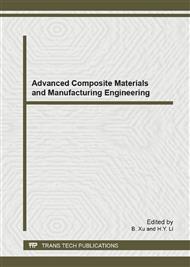p.150
p.154
p.158
p.162
p.167
p.171
p.175
p.179
p.183
Application of ANSYS in Electric Field Distribution of Ti-Al Layered Composite Materials
Abstract:
This paper changed the matrix structure model of traditional electrode materials from the the composition of the internal structure of the matrix, used solid-solid compound method of hot pressing diffusion welding for sandwich type structure Ti-Al layered composite materials, The Ti/IrO2-Ta2O5 were got by typical oxygen evolution model coating ingredient(mole ratio of Ir to Ta was 7:3). Microstructure of the layered composite materials was studied by scanning electron microscope (SEM) and Energy Dispersive Spectrometer (EDS), and then the current distribution performance as the anode material for nickel electrowinning in NiSO4-H2SO4 system was characterized by electric analysis module of ANSYS program . The results showed that, The findings indicate that the interface formation of Ti-Al layered composite materials was a reaction-diffusion process. In the technology conditions of this subject, the phase of interface was Al3Ti. Compared with the traditional DSA (Dimensionally Stable Anode) titanium anode, the Ti-Al layered composite anode showed a more uniform current distribution performance.
Info:
Periodical:
Pages:
167-170
Citation:
Online since:
October 2012
Authors:
Price:
Сopyright:
© 2012 Trans Tech Publications Ltd. All Rights Reserved
Share:
Citation:


